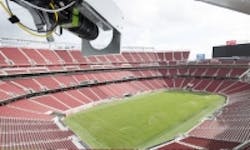Vision system provides immersive 3D replay capabilities at Super Bowl 50
An advanced vision system that features 36 industrial cameras and proprietary algorithms was installed at Levi’s Stadium at Super Bowl 50 in order to provide an immersive, 3D look at game replays throughout the global broadcast.
Replay Technologies’ freeD (free dimensional video) captures true 3D scenes that can be tapped to produce any desired viewing angle. The system utilizes 36 Spark Series SP-20000 industrial cameras from JAI that are mounted around the around the upper level of the stadium to continuously capture the action from every angle. SP-20000 cameras feature the 20 MPixel CMV20000 CMOS image sensor from CMOSIS, which features a 6.4 µm pixel size. The cameras also feature built-in high dynamic range mode, which is designed to handle the high contrast sun and shade conditions common in outdoor stadiums, golf courses, and other sports venues. The specific model used for the system was an SP-20000C-PMCL color camera with a dual mini-Camera Link interface.
FreeD technology, according to Matteo Shapira, chief technology officer and co-founder of Replay Technologies, works by capturing images not just as a 2D or a stereoscopic representation, but as a true 3D scene, comprised of three dimensional "pixels" that faithfully represent the fine details of the scene. This information is stored as a freeD database, which can then be tapped to produce any desired viewing angle from the detailed information.
Synchronized feeds of high-resolution video are processed using algorithms from Replay Technologies to create a 3D database of voxels. After the the freeD database is created, an interactive real-time rendering engine allows for the viewing of the captured scene from any desired angle (as long as it is within the coverage range of the original sensors).
To ensure success, Replay Technologies partnered with Intel Corporation, who provided sponsorship, as well as support with the installation of all the cameras and computer equipment.
CBS dubbed the system "Eye Vision 360," a reference to both its advanced vision capabilities and the iconic CBS “eye” logo. The broadcast team utilized the system for multiple replays throughout the game, including the breaking of an imaginary “goal plane” to confirm one of the Denver Broncos’ touchdowns. This ability to view the scene from different angles, according to JAI, gave TV audiences an experience that have previously only seen in motion picture special effects, such as those pioneered in the movie “The Matrix.”
The freeD system was originally introduced at the 2012 Players Championship PGA golf tournament and later that summer at the London Olympic Games gymnastics event. Tennis, soccer, and basketball are a few of the other sports broadcasts where the system has been previously deployed.
View more information on Replay Technologies.
View an interview with Matteo Shapira, CTO Replay Technologies.
Share your vision-related news by contacting James Carroll, Senior Web Editor, Vision Systems Design
To receive news like this in your inbox, click here.
Join our LinkedIn group | Like us on Facebook | Follow us on Twitter
About the Author

James Carroll
Former VSD Editor James Carroll joined the team 2013. Carroll covered machine vision and imaging from numerous angles, including application stories, industry news, market updates, and new products. In addition to writing and editing articles, Carroll managed the Innovators Awards program and webcasts.
